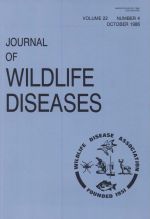Five captive moose calves each infested with 42,000 larval Dermacentor albipictus, six calves each infested with 19,000–21,000, and five control moose were observed for changes in hair-loss, body condition and number, stages, and distribution of the tick. Winter hair-loss was observed only in moose infested with ticks and was correlated positively with the total number of adult ticks. Hair-loss associated with ticks was minimal from October to January, but rapidly increased from February to April when up to 44% of hair had been removed. The pattern of hair-loss was similar in all moose with the neck, shoulders, withers, and perianal areas losing the most hair. Moose with extensive premature hair-loss had less pericardial and abdominal visceral fat than moose with little or no hair-loss.
How to translate text using browser tools
1 October 1986
TICK (DERMACENTOR ALBIPICTUS)-INDUCED WINTER HAIR-LOSS IN CAPTIVE MOOSE (ALCES ALCES)
R. F. McLaughlin,
E. M. Addison





